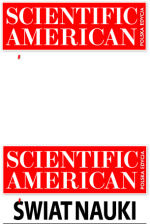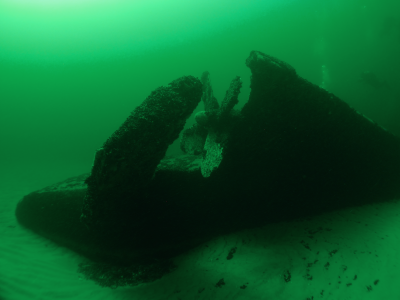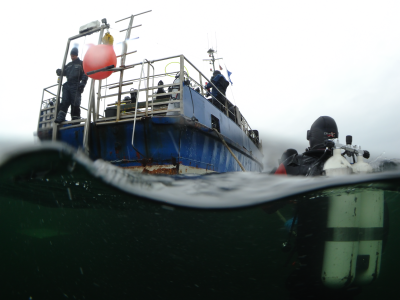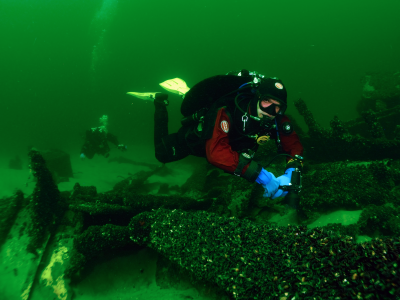 2006
2006
 2008
2008
 2010
2010
 2012
2012
 2014
2014



 |
‘Wrecks teeming with life’
Shipwrecks as centers of marine biodiversity – inventory of fauna growing on wrecks in Polish coastal waters and estimation of its influence on the marine environment
PIOTR BAŁAZY – author of photographs The propeller of M/S Christa. The ship is inverted. Near Wladyslawowo, May 2012 After surfacing the boat is already waiting. Gulf of Gdansk, February 2011 Looking for a place to collect samples. Near Wladyslawowo, May 2012 |

|
Description popularizing the research project
Wide sandy beaches of Baltic Sea are a natural extension of its bottom. Fine sand, which shifts softly under holidaymakers’ feet, covers most of the Baltic seabed. Wavy water ceaselessly sweeps and moves grains of sand just as the wind does it with the white dunes between ?eba and Ustka. Abundant vegetation has a tough task to get a grip on such a ground. It is quite the same underwater. Yet in the underwater sand desert, there are oases teeming with life anchored to the solid, stable ground. Apart from the few rubble areas in the mid-part of the Baltic shore, the enclaves of life develop on the wrecks scattered on the bottom. Sunken in numerous sea battles and catastrophes, the ships attract attention of not only naval historians, armament experts, or adventurers and treasure hunters. In the spots where fishing boats and sailing ships sank, you will also see marine biologists dressed in diving suits. Although the depths of the Baltic are far from the azure and sapphire of the southern seas and its waters are murky, shallow and polluted, although sharks will not suddenly attack the brave daredevils, yet in places like these, biologists find surprisingly rich life. Floating in green glow, inch by inch, they search the wrecks and describe the organisms on wooden and steel hulls of the ships. The wrecks turned into artificial reefs and their colonists make life in the Baltic richer. Poets are in love with the immortal myth of the mighty British liner, the wreck of which lies 4 thousand meters deep near the Eastern coast of North America. They keep singing ‘Leave the Titanic alone’. The legend of the unsinkable Titanic and her dramatic end remains unsurpassed, but the Baltic wrecks should remain where they rested forever. Their end became a link in the eternal chain of life.
Abstract
Sandy and muddy sediments cover most of the seabed in the Polish Baltic Sea coastal area. Benthic fauna inhabiting these sediments is relatively well known and have been already described in the scientific literature. Natural hard-bottom habitat is limited to very few sites with boulders. The largest such an area is Slupsk Shoal. In this context, hard bottom elements created by shipwrecks are of particular importance for biodiversity and ecosystem functioning in the Polish coastal zone of the Baltic Sea. Shipwrecks may create biodiversity hot spots. Increasing the level of heterogeneity of benthic habitats by providing a solid surface for fouling communities such as mussels (Mytilus sp.), shipwrecks support many important roles of benthic assemblages such as e.g. filtering seawater. The goal of the project is the inventory of shipwreck fauna together with biodiversity, density and biomass assessment in the Polish economic zone. The collected material will help us answer the question whether the properties of benthic communities are dependent on the size, depth and location of a wreck or the distance between two wrecks as well as describe the seasonal variability of the examined communities. The study is based on quantitative samples collected by scuba divers. Each sample consists of organisms inhabiting the standard area of the substrate defined by a 0.25x0.25 m square plastic frame.
Patronat honorowy
Leszek Jodliński
Dyrektor Muzeum Śląskiego w Katowicach
Zygmunt Łukaszczyk
Wojewoda Śląski
Jan Malicki
Biblioteka Śląska
Piotr Uszok
Prezydent Katowic
Adam Matusiewicz
Marszałek Województwa Śląskiego
















